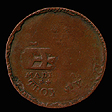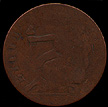Blacksmith Coppers
obverse |
|
reverse |
| |||
Wood 28a Blacksmith Copper
Obverse: [outer rim starting at 12:00] PECK'S PATENT TIN MACHINES * [then, in the center field] * * [four petal rosette] * * / IN COMPLETE / SETS. / [illustration of a spindle] / MADE AT / * * * * * / TROY N.Y.
Reverse: [No legend]
Weight: 52.0 g (3.37 grams) Diameter: 25.87 mm Reverse die alignment: 30°
Comments: This item is one of a group of coppers reusing the dies from two Hard Times token dies that had originally been produced by Daniel and Benjamin True of Troy, New York about 1835. The two tokens are HT 363, a token for J. & C. Peck of Troy, New York and HT 366 a token for N. Starbuck and Son of Troy, New York. See the introduction for more information on this group. The example shown here contains the obverse of HT 363 joined with a Britannia reverse. The obverse die was quite worn by the time this variety was struck therefore much of the text and half of the illustration were not impressed into the planchet. Several letters from the outer legend are partly visible on the outer rim. All of the stars listed in the transcription of the complete legend have six points; in the top line of the center field the two outer stars are smaller while the two inner stars are larger, in the next to the last line the star pattern alternates as follows: small, large, small, large, small.
The reverse displays a seated Britannia facing right. The Charlton Catalogue (3rd ed.) identifies this reverse with that of Wood 23. It certainly shows many similarities to the intermediate state example displyed on this site. Unfortunately some significant areas were not well struck, so some comparisons are not possible (eg. the head and neck are worn on this variety, while on Wood 23 Britannia's raised left arm, which is to the right, is worn).
Wood did not know of this combination, the number Wood 28a was created by Oppenheim in his catalog of the Warren Baker Collection (this is part of the March 1987 Bowers and Merena auction catalog entitled The Frederick B. Taylor Collection and Other Properties, item 1067 on p. 110). The Charlton number is BL-46 where it lists a weight range of 3.3 to 3.4 grams and a diameter of 25.9mm, Rulau,in his Standard Catalog of United States Token 1700-1900, (2nd ed,) lists this item under the Hard Times Token series as, HT 365 (previous listed as Lyman Low HT 272A). Both the Baker collection entry and the Charlton catalogue state there are only four examples known. The Notre Dame example would be a fifth example.
Provenance: Donated to Notre Dame in 1887 as part of a 2,300 item coin collection (see: The Notre Dame Scholastic, vol. 21 (September 1887) 45.
obverse |
|
reverse |
| |||
Wood 33 Blacksmith copper
Obverse: GLORIUVS · III · VIS
Reverse: BITIT · [or possibly BRTIT ·]
Weight: 87.7 g (5.69 grams) Diameter: 26.8 mm
Comments: This coin is an enigma with several differences from the standard Blacksmith coppers. In fact, at one time it was considered to be linked to the Vermont copper series. Whereas most Blacksmiths were made without lettering, this coin has legends on both the obverse and reverse. Oppenheim noted, "The lettering appears to be from punches and the fabric and planchet size are more regular than for most blacksmiths. Perhaps the die was prepared in England by recutting some earlier evasion halfpenny and then shipped to North America." (Baker catalog, p. 111, item 1077). Also, more examples of this coin survive that any other Blacksmith, leading one to suspect it was minted in much larger quantities. These differences have led some to question if the coin properly belongs in the Blacksmith series. Indeed, Anton and Kesse consider this variety to be a British evasion issue.
The obverse has a bust right laureat portrait described as having a 'pug' nose. The legend was transcribed as GLORIOVS in the Charlton catalogue, but from this example it is clear that the thin line on the right side of the letter taken to be a second O is acutally a U.
The reverse shows a portion of a legend and displays a seated Britannia facing left, holding what appears to be a shamrock. Although Brittania faces left on regal issues, all other Blacksmiths have Britannia face right. In fact, the only onther left facing reverse is on the Blacksmith imitation of the Tiffen Tokens (BL-32 and BL-33, the second is Wood 21) which show Justice facing left. The reverse legend is listed as BITIT in the Charlton Catalogue, however on this example the second letter, thought to be an I has some charasteristics of an R. What would be the bottom of the bow of an R is visible and the bottom of the letter has a serif (unlike the other stroke considered to be an I). The third and fifth vertical strokes have serifs and are taken to be T while the unserifed stroke between them is taken to be the bottom of an I. It is interesting to observe the two letters on the obverse taken to be I have serifs!
In the Charlton catalog this piece is called a "BITIT token" as that is how they read the reverse legend. The Charlton number is BL-37 where it is listed with a weight range of 5.6 to 6.1 grams and a diameter range of 26.5 to 26.8 mm.
Provenance: Donated to Notre Dame in 1887 as part of a 2,300 item coin collection (see: The Notre Dame Scholastic, vol. 21 (September 1887) 45.
| Blacksmith Coppers, p. 1 | Section Contents | Barbados Coppers |
|
For viewing tips and information on optimal computer settings click
here.
For questions or comments contact Special Collections by: |



